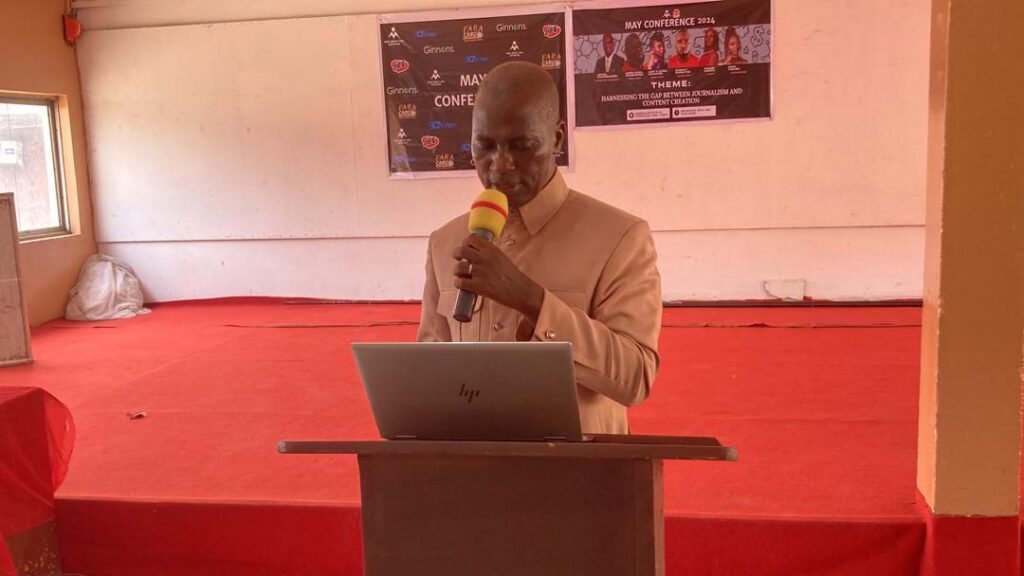Excerpts from the keynote address by Executive Director, Media Career Development Network, Lekan Otufodunrin at May Conference 2024 on Harnessing the gap between Journalism and Content Creation.
For asking me to speak on harnessing the gap between journalism and content creation, the lead organiser of MAY Conference, Joan Yakubu should add Mind Reader to her profile on various platforms.
Sometimes last year, I reflected on how content writing is now a big deal and much-needed skill, but not many mass communication departments in our tertiary institutions offer it as a course in an X post.
Media trainer and founder of Journalism Clinic, Mr Taiwo Obe, whose profile describes him as a Thinker. Doer. Human on X responded that the course should be Content Creation since the content will determine the format to be used. I agreed that it’s about conceptualisation and operationalisation beyond just writing.
In another chat with him, as we are both passionate about how more media organisations and journalists in Nigeria can become digital in their operations instead of still being analogue in their supposed digital operations, I wondered why many legacy media houses don’t have Content Editors in their Online teams because Content creation, more than just news, requires some creativity and can keep more people on the websites and social media platforms when there is no major news.
His answer was ” They still do not understand what content means.” The saying that content is king is old, but many media organisations still do not treat it as King in line with the constantly changing media landscape.
The above discussion with TO confirms my worry about the gap between journalism and content creation which should be the focus of a major media programme like the one we are here for today. Once again we have to thank the organisers for taking the initiative to organise this event at a Journalism Institute that should like others be at the forefront of adequately preparing new media graduates for the new reality in the industry using flexible curriculum.
Without a doubt, there is a gap that needs to be mended before it’s too late and harnessed for the benefit of especially professional journalists and their organisations who have not fully appreciated the need to diversify their online offerings as much as possible, beyond traditional editorial content of news, features, views and others also presented in traditional format.
Some legacy organizations are doing their best to catch up in engaging in one form of content creation or another, but many still have a long way to go to wake up from their slumber as we did in the early days of blogging and social media use when we assumed that it was a fad that had no place in journalism that would soon fizzle out.
We were wrong. It took us time to realize how we were no longer the sole gatekeepers of news and other information and we had to play catch up as we are doing with content creation.
To be sure, lets agree on what journalism and content creation are to be able to harness the gap for the good of all.
According to the Encyclopedia Britannica, journalism is “… the collection, preparation, and distribution of news and related commentary and feature materials through such media as pamphlets, newsletters, newspapers, magazines, radio, motion pictures, television, books, blogs, webcasts, podcasts, and e-mail.” This definition should be updated to include social media.
The role of the media, which journalism is part of is to inform, educate and entertain.
Content creation, by a definition, is said to be the process of identifying a new topic you want to write about, deciding which form you want the content to take, formalizing your strategy (keyword or otherwise), and then actually producing it.
Wikipedia states that Content creation is the act of producing and sharing information or media content for specific
My brief for this keynote address is to highlight similarities and differences between content creation and traditional journalism. In addition, I will speak on the role of authenticity and credibility in both fields and how journalism skills can enhance content creation.
There are clear similarities between the two. They both involve information dissemination. The goal is to educate, inform, entertain and additionally for content creation, inspire.
READ ALSO: NEW: Nigeria Media Capacity Development Report 2023 released
At the recent media leaders summit in Abeokuta, Popular stand up comedian, Ali Baba expanded the role of media content of all sorts to include connect, document, shape society, advisory, curate, celebrate, monitor, promote among others. Don’t ask me what Ali Baba was doing at a media leaders summit. He is not a journalist, but understands media issues so well from his contributions based on his engagements in media sector.
While journalists are trained and certified media professionals, content creators don’t have to be, though there are now training and certification for content media roles. While a journalist can easily expand his or her work to include content creation, a content creator cannot easily play the role of journalist.
What binds us together is the content we have to offer our audiences who don’t know this distinction but have insatiable thirst for information, knowledge, ideas and more from any platform that can offer them.
The above reason is why journalists can no longer limit themselves to offering traditional editorial content in the formats they are used to if they still want to be reckoned with as a source of information that is more than just breaking news. People want information they can use for various aspects of their lives and expect media organisations and their journalists to include them in their offerings as some local and international platforms do.
Content creators don’t mind taking over the professional roles of journalists using editorial content we provide, journalists are the ones who need to assert their position as the more reliable sources of information by being more digitally compliant.
- To harness the gap between journalism and content creation, journalists need to learn the new skills required to produce multimedia content across platforms.
- They must be able to re-purpose their content apart from the original format which may be tedious for many young audience.
- How can we turn our lengthy reports into Listicles of the major points that will interest readers?
- What of having Explainers for major issues that have to be broken down for the average persons to understand?
- Timelines will provide helpful background to understand new developments
- Audio-slides of photos will enhance our photo journalism reports.
- Sound bites videos on key aspects of a long interview will get the attention of the audience.
- How about newsletters on specific life and career issues?
- Can newspapers have Podcast format of their editorials?
- Journalists must become thought leaders on various issues they cover with the abundant sources and years of experience on their beats.
While I don’t want to advocate that journalists go down the road of being skirt makers and influencers, we must find some engaging ways of getting the attention of our audience in a more matured way.
For content creators who don’t have professional training and journalists who want to get involved in content creation they need to appreciate the need to be guided by the ethics of information dissemination. According to the Code of Ethics for Nigerian journalists, Truth is the cornerstone of journalism and every journalist should strive diligently to ascertain the truth of every event.
It’s important to ensure accuracy and fairness in whatever content shared on any platform. Content should be well researched and factual to avoid misleading the audience.
Content creators should not become too desperate to earn revenue that they promote values that are not in the interest of the overall development of our country.
They should avoid plagiarising content of other persons and organisations and violating copyrights.
Many are engaging in content theft and not content creation as a legal practitioner who spoke at our recent summit in Abeokuta explained. There is need for more creativity and originality instead of the cheap duplication of ideas we see around.

